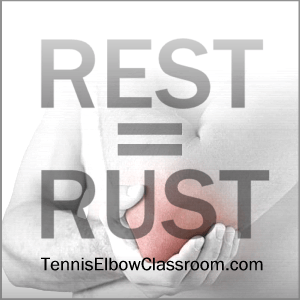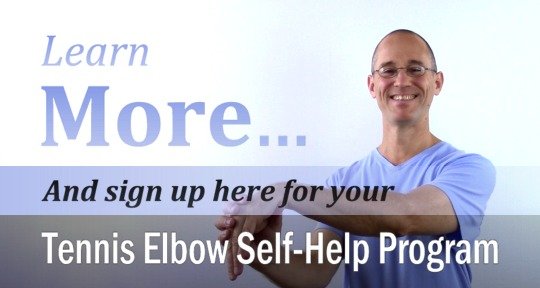When you have Tennis Elbow you always seem to hear how important it is to “rest it as much as possible while it heals” – Or so they say…
Unfortunately, the idea that healing will “just happen” while you’re resting, hoping and waiting is a major misconception when it comes to tendon injuries.
This video and podcast reveal why “You should rest it!” may not be the most helpful advice when it comes to treating your Tennis Elbow
And why “How long should I rest it” may not be quite the right question, since tendons need a lot more than rest in order to heal.
See also my post and video on the related question of: “How long does Tennis Elbow take to heal?”
Podcast: Why Rest Is Rust When Treating Tendons
Here’s an improved, better-sounding version of the braces podcast that you can download and keep by clicking the “download” link under the player below:
Rest And The “RICE Protocol” – Why It Doesn’t Apply To Tennis Elbow Treatment (Usually)
Rest is the first part of the RICE protocol – R. I. C. E. for rest, ice, compression and elevation, the first three parts of which are often recommended for treating Tennis Elbow.
But the reality is this RICE advice doesn’t apply to Tennis Elbow at all, because it’s usually not that kind of injury! (Most of the time.)
Why ice is not a good way to treat Tennis Elbow – (Article and video)…
So what’s wrong with resting it as much as possible?
Because we’re dealing with a tendon injury and with tendons, healing doesn’t just happen automatically the way we think it should if we rest it and give it time.
If you follow the standard advice – If you just sit back and try to protect it by moving it as little as possible, there’s no guarantee any healing will happen in your tendon at all.
See also: How long does Tennis Elbow take to heal? – (Article and video)
We’ve all experienced minor cuts and scrapes and seen them heal quickly and steadily by themselves, so it’s perfectly natural to assume it works the same way on the inside.
It does in many ways, but when it comes to tendons, healing can very easily stall, remain stagnant and elude us.
With tendons the process often needs a lot of encouragement; to be helped along at every step.
Too much rest and too little movement allows muscles and tendons to weaken.
Absolute Rest Is Rust!
Here is a quote is from Dr. Nirschl a thought leader in the understanding and treatment of tendon injuries – Especially Tennis Elbow:
“Absolute rest is rust. All tissues especially injured tendons require tension and motion to maintain health. …Total immobilization is obviously contra-indicated as it results in muscle atrophy, weakness, and decreased blood vessel supply.”
The Nirschl Orthopedic Center / Virgina Sportsmedicine Institute
www.nirschl.com/pdf/tennis-elbow-rehab.pdf
So, tendons need tension and motion to heal, rehabilitate and stay strong and healthy (and reverse degeneration.)
In other words, to try and keep your tendons from moving at all (total rest) is not the proper treatment for Tennis Elbow because it causes muscle weakness and atrophy, and decreased blood supply.
 And full immobilization of the elbow joint itself is especially bad, potentially leading to loss of motion and function of the elbow.
And full immobilization of the elbow joint itself is especially bad, potentially leading to loss of motion and function of the elbow.
Splints, braces, straps and tape all restrict movement and circulation to varying degrees, and can slow your healing down.
Yes, even though you may feel better when you’re wearing them! Like most so-called treatments they’re very deceptive.
See this article and video on braces as a Tennis Elbow treatment.
Now, does this mean you don’t need to bother reducing the activity that caused your Tennis Elbow in the first place?
No. Not at all. If it’s practical for you to reduce the activity then by all means cut down or stop for a while.
Especially if it’s a recreational activity you can easily reduce, rather than a work activity that you may not be able to avoid.
The idea is to stop or reduce the aggravating activity and motions – But not to stop all motion.
AND it’s still very important to ensure that you get enough rest in general – as in enough sleep – because that’s when most of your healing happens.
Keep in mind that tissue repair is not the body’s top priority, so if you cheat it out of quality sleep and don’t get your full 8 hours, it may take longer to heal!
How Much Motion Is Needed To Aid Tennis Elbow Healing?
It may still sound counter-intuitive, or even completely nonsensical, but regular, gentle movement is essential to muscle and tendon healing.
And some pain is to be expected since healing is inherently painful in the beginning.
You can’t let the pain dictate that you never turn a doorknob or take a milk jug out of the fridge with your Tennis Elbow arm just because it often hurts.
Try to keep doing daily activities normally. You’re not going to be damaged by turning a doorknob, even if it hurts.
Just don’t spend six hours in a row gardening or on some home-improvement or maintenance task!
The key is to find the right amount of tension and motion to support your healing at each stage of healing and recovery as you progress.
- In the very early stages this may be simply moving your wrist and elbow gently through the normal range of motion repeatedly throughout the day.
- And soon thereafter to introduce some very gentle stretching – And then some hands-on therapy, which we’ll get to momentarily…
- Eventually you’ll need to include strength-building exercises, but that may not be appropriate until the latter stages, (although some people can start them fairly early.
The challenge with tendon injuries is to keep the healing process going – To keep encouraging and stimulating it to keep it from stalling.
Because that’s what happens all too often. The process stalls, healing fails, and the tendon gradually breaks down.
And too much rest and too little tension and motion simply allows that degenerative breakdown process to continue on its downward spiral
It allows circulation and the healing process to stagnate.
There is a balance, naturally. If you go to the other extreme and try to jump right into a challenging exercise program right away it could easily backfire – Too much tension too soon could damage your tendon and worsen your Tennis Elbow.
By Hand: The Best Kind Of Tension And Motion For Healing
Now, I’m a Neuromuscular Therapist. I treat these injuries by hand with advanced therapy methods that I hesitate to call massage techniques, as well as teach people how to treat themselves with these same advanced methods.
In my opinion and experience, hands-on therapy is the best kind of tension, friction and motion that has the most positive effects on healing.
It’s helpful in the early, middle AND latter stages of healing.
Again, the challenge with these injuries is to keep the healing process going to keep stimulating your tendon – And regular, direct manipulation – By hand – With the right techniques really helps with this.
I know this can be rather expensive if we’re talking about visiting therapists like myself for treatment, but the good news is you can learn techniques and use them to help yourself – And I’m happy to be your tutor and teach you how!
So, in conclusion:
- “Rest” doesn’t mean stopping all movement – just the aggravating causal activity,
- Tendon healing doesn’t happen automatically just because you rest,
- Tension and movement are essential to your healing process,
- And you have to find the right amount for the stage of healing that you’re currently at.
Learn To Treat And Heal Your Own Tennis Elbow Or Golfer’s Elbow At Home With This Video Program
You’ll get instant access to a complete VIDEO program designed by a professional therapist to help you take charge and break your vicious cycle of pain and frustration!…
I’ll be your personal tutor guiding you through step-by-step video lessons, where you’ll get the therapy techniques, key stretches and essential exercises you need to treat and recover from your injury at home. (Without any special equipment.)
Just watch the videos, follow along and start putting an end to your elbow pain today, whether you have Golfer’s or Tennis Elbow from playing tennis or golf, playing a musical instrument or from ANY cause!)
Tennis Elbow sufferers: Learn more about the Tennis Elbow program here
Golfer’s Elbow sufferers: Learn more about the Golfer’s Elbow program here







I am searching for help regarding the tennis elbow I have been suffering with for many months now.
Great articles & site… thanks for sharing all the info!
Well written and well explained – I was on the look-out for an elbow support so I can keep exercising (have just stumbled upon tennis elbow… booo) but after reading, I won’t be icing and I’ll be soldiering on through (sensibly) to try and heal fast and get on with things!
Thanks again!
How long do I have to be off work after getting injection for tennis elbow
I have no idea, Louise. That’s a question for your Doctor if you decide to get one – (or have you already had one?) I would think twice about getting one if you haven’t already done it. ( See my article on Cortisone shots here )